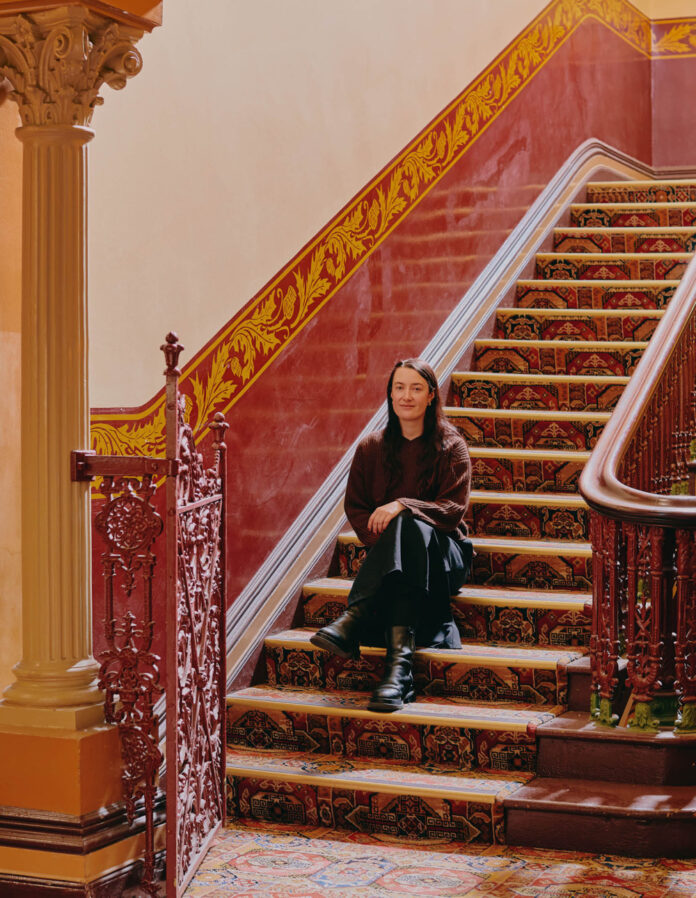[ad_1]
Tia Ansell’s Uniquely Layered ‘Weaving-Paintings’
Studio Visit

Artist Tia Ansell on the stairs in Fitzroy Town Hall, where works in her studio as part of the Conners Conners Gallery. Photo – Amelia Stanwix for The Design Files

Tia uses a mix of weaving and painting techniques to create her colourful and contrasting artworks. Photo – Amelia Stanwix for The Design Files

Her weaving-paintings are inspired by architecture, which she then translates into a ‘code’ for her to weave! Photo – Amelia Stanwix for The Design Files

This code is then translated into various colours and threads of the warp on her loom. Photo – Amelia Stanwix for The Design Files

Setting the loom correctly is a key part of the process, as she has to make sure the threads are in the right sequence and length, and the tension is perfect as there is no going back to fix it during the weaving process. Photo – Amelia Stanwix for The Design Files

She repeats these ‘codes’ or patterns several times depending on how large her piece is going to be. Photo – Amelia Stanwix for The Design Files

A work in progress! Photo – Amelia Stanwix for The Design Files

‘I mainly use cotton for the rigid nature, but I also use linen, bamboo and silk. I may introduce another pattern into the weft, for a double patterned work,’ Tia says. Photo – Amelia Stanwix for The Design Files

Photo – Amelia Stanwix for The Design Files

‘The paintings are a more accurate representation of patterns or geometric design elements found in our urban landscape. They’re flat, hard edged yet sit within the weaving plane,’ Tia adds. Photo – Amelia Stanwix for The Design Files

Her use of colours and style is influenced by the art movements of Constructivism and Bauhaus. Photo – Amelia Stanwix for The Design Files

Photo – Amelia Stanwix for The Design Files

The final steps are to varnish the works before framing them in aluminium for a striking mirrored effect. Photo – Amelia Stanwix for The Design Files

Photo – Amelia Stanwix for The Design Files

One of Tia’s finished works! Photo – Courtesy Tia Ansell

Photo – Courtesy Tia Ansell

The fabric gives them a wonderful textural quality, thanks to Tia’s creation of her one-of-a-kind canvases! Photo – Courtesy Tia Ansell

Photo – Courtesy Tia Ansell
Artist Tia Ansell started weaving ‘properly’ in her first year of art school – where she also built her own loom.
‘You can essentially weave on anything – a frame, a fork, your fingers,’ Tia says. ‘Over the last year I have collected three looms of different sizes and builds (floor and table). I have done various weaving courses or visited weaving mills in Ecuador, Peru, India, Sri Lanka.’
‘Weaving is inherent to human material culture; it is a characteristic of being human. We dress in it, we sleep in it.’
Growing up in Auckland, Tia was exposed to Aotearoa’s rich weaving culture from a young age, but initially focused on painting, and came to Melbourne to study fine art at the prestigious Victorian College of the Arts.
‘I had always kept my weaving and painting practices separate,’ Tia says. ‘The ideas and contexts surrounding geography, architecture and psycho-geography have always been an interest for me, but the execution and process have evolved.’
She even dabbled in metal work and ceramic assemblages, alongside weaving and painted elements, before arriving to her current practice, which she calls ‘expanded painting’. The endless time for reflection during the pandemic triggered the ‘light-bulb moment’ to bring the two practices together.
Now working alongside other emerging artists in the Conners Conners Gallery, inside Fitzroy Town Hall, Tia has perfected the unique method behind her intricate pieces. She handcrafts every element of these works, from weaving of the base fabric, to the final painted artwork.
These ‘weaving-paintings’ begin as drawings of Tia’s local surroundings and facades of buildings. Referencing architectural lines and patterns, the artist creates her own ‘code’ with corresponding colours and threads of cotton, linen, bamboo or silk. Hours of hand-weaving at her loom turns these into beautiful fabrics, that are then stretched and primed ready to be painted on. A small work can take around 12 hours to complete, while larger ones can take anywhere between a few weeks to months!
‘Each step is very important,’ Tia says. ‘If I’ve missed a weft thread or similar, I embrace it and rarely go back to fix it. I like this kind of mistake.’
It’s this meticulous process that makes the resulting artworks – encased in a striking silver frame – so distinctive and impressive.
See more of Tia’s work on her website.
[ad_2]
thedesignfiles.net










